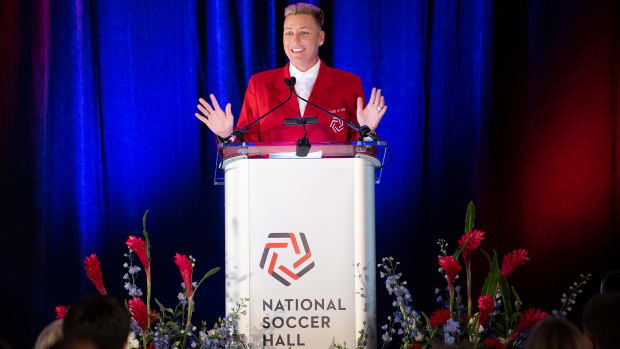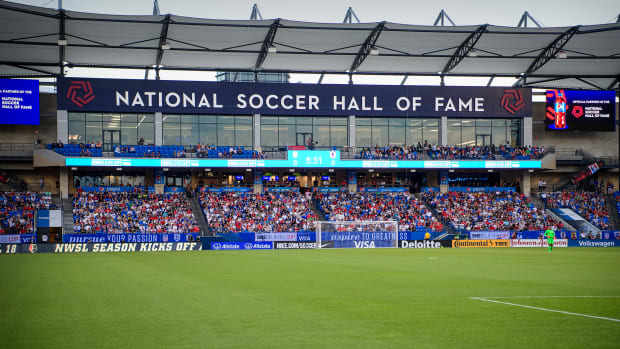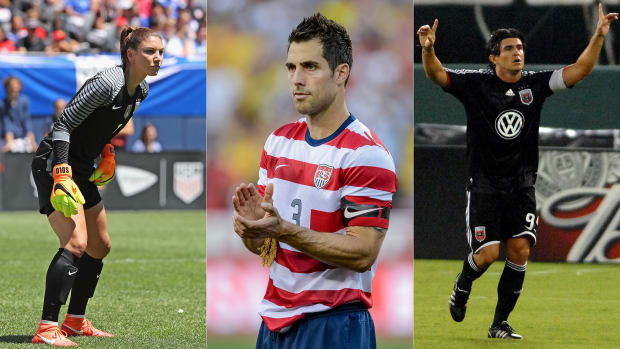Outcry over egregious snubs has repeatedly drowned out celebration over inductees in recent years, and the process to select those deserving of U.S. soccer's highest honor is changing as a result.
Hope Solo was stealing headlines yet again, but not for her outstanding play on the field or her outspoken nature off it. This time, it wasn’t her doing at all.
What should have been a day of celebration for Carlos Bocanegra (and Solo, and maybe others) evolved quickly into one of criticism. Bocanegra wasn’t at fault either. It was early September, and the former defender and current Atlanta United technical director had reached the zenith of his American soccer life—induction into the National Soccer Hall of Fame.
The conversation should’ve been focused on Bocanegra and his journey toward that moment. Instead, a lot of it was about who wasn’t joining him. Solo, the greatest goalkeeper in women’s soccer history, somehow fell short of induction. So did Steve Cherundolo, whose club career in Europe and years with the U.S. national team were every bit as impressive as Bocanegra’s. Their exclusion, especially Solo’s, was shocking. It became the story.
In fact, for the fifth time in six years, just one man or woman was elected to the NSHOF off the player ballot. It felt like it was becoming the most pointlessly exclusive club in sports. And there’s been controversy even when a deserving player was elected, like last year, when record-setting striker Abby Wambach inexplicably appeared on only 80.9% of the 178 ballots cast (a 66.7% threshold was required). Something wasn’t right.

“What frustrates me, and has really made us look at this process over the last couple of years, is that when we do come out and announce our class, a lot of times it’s about who didn’t make it instead of who did, and I don’t like that,” NSHOF executive director Djorn Buchholz told Sports Illustrated. “I’m incredibly disappointed Hope didn’t get in, but that was the conversation. I think doing this will help.”
The “this” to which Buchholz referred was an overhaul of the screening and voting process that determines which retired players, coaches, and contributors are awarded American soccer’s highest honor. It’s been broken for years, and a revision has been in the oven for months. On Thursday, it’s set to be unveiled.
“There will still be people on the bubble, and still conversations about who didn’t get in. But I hope going forward they won’t be so significant,” said Buchholz, who revealed that both Solo and Cherundolo would’ve been voted in under the new system.
“This process will result in two-to-four people going into the Hall of Fame, more than likely three or four people, each year,” Buchholz added. Two or three of those inductees will come from the player ballot.
The new election procedure is complex (it’s 10 pages long), but it’s underpinned by a couple of key principles—reducing the number of people on a ballot to ensure votes aren’t so easily spread among too many candidates, and narrowing the pool of voters to ensure it’s comprised of engaged experts who closely follow the game. Screening committees will be formed to discuss and determine who makes the final player, veteran and builder ballots, and a mechanism has been created to add potential candidates who’ve contributed in novel ways (think of someone like Taylor Twellman, whose playing and broadcasting career plus concussion advocacy might combine to warrant induction, or former U.S. Olympic and University of Portland coach Clive Charles, or former U.S. defender and humanitarian Tony Sanneh).

“The [screening] committees can actually have these educated discussions and by cutting the number of eligible people that can vote in half, we can really have educated, focused conversations on what it means to be in the Hall of Fame and who’s deserving, and we’re looking forward to that,” Buchholz explained.
The NSHOF museum is located at FC Dallas’s Toyota Stadium, and the Hall itself is a nonprofit organization operating under the U.S. Soccer Federation that’s run by its own board of directors. The members of that board will be familiar to U.S. fans—former USSF president Dr. Bob Contiguglia, former USSF CEO Dan Flynn, current USSF president Cindy Parlow Cone (she was on the Hall board before taking office), USSF board member John Motta, and Hall of Fame inductee Cobi Jones. The board was involved in establishing the new voting protocols.
Potential inductees will continue to be separated into player, veteran and builder categories. Players must have been retired for three years, then will remain eligible for consideration for seven. Veterans are players who’ve been retired 10 years or more. And builders include coaches, administrators, referees and everyone else.
To be eligible for consideration, players will have to have played either 20 or more full internationals for the men’s or women’s senior national team or one of U.S. Soccer’s “extended national teams” (beach, futsal and paralympic, which are being considered for the first time), or at least five seasons in a U.S. first division pro league (with at least one Best XI appearance). Those criteria haven’t changed. The difference is that they’re now not enough to get on the ballot.
From now on, an 18-member screening committee appointed by the NSHOF will rank the eligible players to produce a 20-person final ballot. Screening committee members will serve three-year terms and will be 1/3 NSHOF members, 1/3 media/historians and 1/3 coaches and administrators. The screening process is designed to include meetings and conversation that will allow members to advocate for, or argue against, specific candidates. From there, a 48-member voting committee (including screening committee members) with similar composition and term limits will cast their ballots. Previously, the voting committee comprised all NSHOF inductees, more media members (around 75) and a larger contingent of active USSF/MLS/NWSL coaches and management.
In years when both a builder and veteran also are elected, the top two finishers on the players ballot will be inducted as long as they’re named on 50% of the ballots. That’s a new wrinkle that almost guarantees at least two player inductees each year (six players hit 50% in 2020). If either/neither a veteran or/nor a builder is elected in a given year, the third-place finisher on the player ballot also will be inducted if he or she meets a specific percentage threshold.
Buchholz said the conversations conducted by the screening committee will be one place where the NSHOF can address one of its most significant problems, the absence of any MLS players who represented a foreign national team. D.C. United legend Jaime Moreno, almost certainly the player of MLS’s first decade, earned 50.6% of the vote this year as his eligibility on the player ballot expired. David Beckham received 45.5%.

“It’s been hard for those people to get enough votes. I think these screening committees, and having educated discussions about what these people meant to this country is something that hasn’t happened before, and it’s going to really open people’s eyes to some new ideas and new ways to vote,” Buchholz said.
The screening and voting committees for the veterans and builders will be half the size, but will include media/historians for the first time while reducing the number of NSHOF members involved. The voting process will be similar to the procedure followed for the player ballot. The individual veteran and builder named on the most ballots, as long as they reach 50%, will be elected. Builder eligibility now will rotate in a four-year cycle to ensure voters are considering different kinds of contributors. Across four years, the NSHOF will evaluate everyone, then referees only, then coaches only and then other contributors and executives.
The builder category also will feature a waiver system permitting external nominations, which will then be screened and perhaps voted on. Someone who doesn’t meet the specific coaching, refereeing, age or service requirements can receive a waiver to be considered by the screening committee if they’re found to have made “exceptional and unique contributions to the game on a national level” or due to special personal circumstances (injury, death, etc.)
As the game grows across the U.S., the number of people whose contributions transcend categorization almost surely will increase, Buchholz said.
“This will probably be a category that we’ll need to reevaluate again in a couple years as more people become eligible or there are those strange circumstances,” of someone like Twellman or Sanneh, Buchholz said. “It’s about getting back to our mission of making sure that the people that have given the greatest contributions to our game are being honored, and we’ll continue to modify these if we need to to make sure that’s happening.”
From this year forward, the NSHOF will publish the player, veteran and builder eligibility lists, the final ballots, all voting results, and the names of the people on the screening and voting committees. It will remain up to those individuals whether they release their personal ballots.
Last year, the NFL announced a significantly expanded class of Pro Football Hall of Fame inductees in recognition of the league’s 100th season. The idea was to go back and reconsider those who may have been unjustly left out in previous years, or those whose impact might be perceived differently with the benefit of time and a different perspective. Buchholz said the NSHOF has discussed something similar, especially since the voting process has been flawed for so long. Although it’s not something that’ll happen in the next year or two, he acknowledged that the board “thinks it’s interesting and it might make sense down the road.”